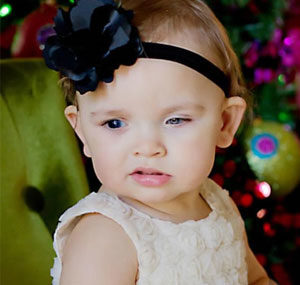
Gentry’s first eye surgery took place on her second day of life, and she received her first cornea transplant at one month old in order to reconstruct her left eye and correct the Peters’ anomaly, a rare developmental disorder that causes corneal opacity. The transplant was a success, correcting the cloudiness and enabling both eyes to move together, but the medical team was also working to reduce the heightened eye pressure caused by glaucoma. After six months, Gentry’s intraocular pressure spiked, necessitating the implantation of an Ahmed valve and the transplantation of a second cornea. This transplant, too, could not sustain her condition, and four months later she received a third corneal transplant at the age of one.
“The treatments took a huge commitment from her doctors,” Becky said of her daughter’s medical team, which consisted of ophthalmologists Dr. Erin Stahl of Children’s Mercy Hospital in Kansas City and Dr. John Sutphin of University of Kansas Hospital. “Her case was so rare, they had to consult each other.” Finally, in August 2012, Gentry received a Boston Keratoprosthesis implant (or “Boston KPro” for short) in her left eye. The Boston KPro is an artificial cornea under development since 1960 that is now the most commonly used artificial cornea in the U.S. and the world. When standard corneal transplantation fails to return sight, the Boston KPro can be inserted into a donated human corneal graft and then sutured into the eye like a standard transplant. Gentry numbers among the more than 7,000 people who have received the implant since 2000, though the procedure remains rare, having been used in less than 1 percent of cornea transplants in 2012.
To date, Gentry has undergone twenty eye surgeries, including three traditional corneal transplants, two Ahmed valve implants, and the Boston KPro transplant. While her daughter has not attained full vision in the course of these complex medical interventions, Becky describes Gentry’s vision positively. “She can see fairly well out of her right eye. She gets around fine and can see things around her,” she said. “We’re not sure about her depth perception, and she has light-sensitive vision, so she wears sunglasses outside. But we know she has light reception in her left eye. She’s just now at the point that she can develop vision in the left eye.”
In order to express her gratitude, Becky has written to the families whose loved ones donated the gift of sight to Gentry. “My daughter couldn’t see if it weren’t for donation and the generosity of people and families who agree to donation,” she said. Though she had not encountered donation or transplantation before her daughter’s birth, Becky knows how important the gift of sight is to people of all ages. “There are babies and young children who have eye conditions. They have the opportunity to be able to see if given that gift at a young age.” Because generous donors and donor families said yes to donation, Gentry has the opportunity for a life she might not otherwise have had. “She has the chance to grow up like everyone else,” Becky said. “She doesn’t have perfect vision, but it’s functional. She’ll be able to read and play like every other child.”
Gentry’s visual development will be gradual and uncertain and, undoubtedly, monitored closely by her ophthalmologists. But thanks to the generosity of her donors and their families, the skill of her medical team, and the patience and support of her family, today Gentry gets to be a very active and intelligent two year-old girl who sees.
Join the eye, organ, and tissue donor registry today to make known your wish to be a donor.
Click here for a 2015 holiday update with Gentry.

